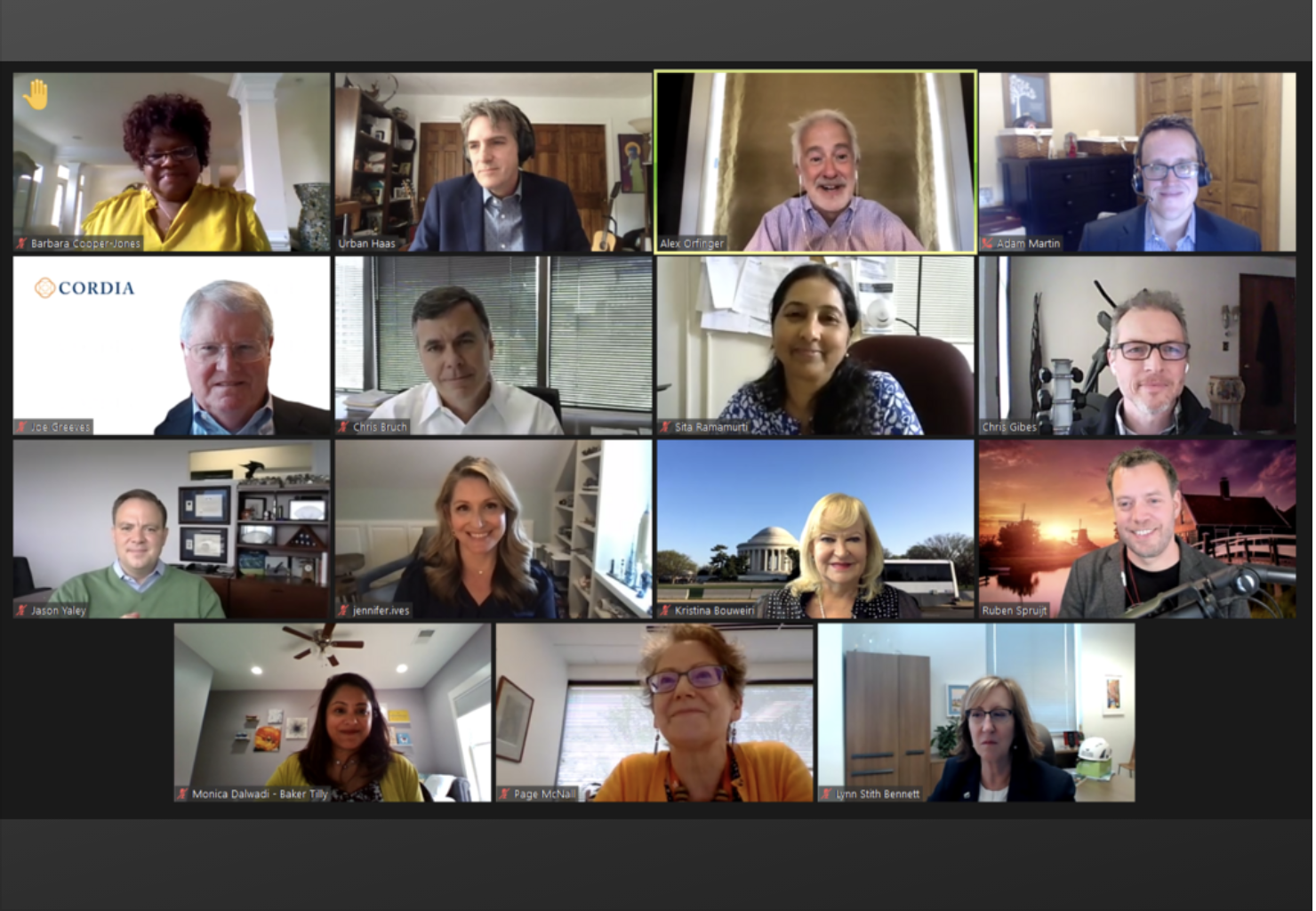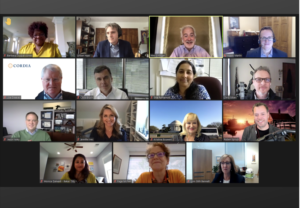
Tech talk: D.C. Execs on Preparing for Return-to-Work and Hybrid Workplace Solutions
The debate around reopening & the hybrid workplace continues & access to & production of technology are coming to center stage. While speaking on a panel, Trinity Washington University’s Dr. Ramamurti remarked, “Women of color are underrepresented in technology fields.”
By The Business Journals Content Studio
 Covid-19 has caused organizations across the country, and across Washington, D.C., to react, adapt and reassess the way they operate. Today, business leaders are strategizing return-to-work protocols and what that might entail from a technology perspective. Whether it’s improving digital workflows, implementing digital transformation solutions, navigating hybrid clouds, or providing employees with seamless, no-touch experiences, the pandemic has changed the way people will work moving forward.
Covid-19 has caused organizations across the country, and across Washington, D.C., to react, adapt and reassess the way they operate. Today, business leaders are strategizing return-to-work protocols and what that might entail from a technology perspective. Whether it’s improving digital workflows, implementing digital transformation solutions, navigating hybrid clouds, or providing employees with seamless, no-touch experiences, the pandemic has changed the way people will work moving forward.
At the recent “Tech Connect: A Virtual Discussion” event sponsored by Fortune 200 technology firm CDW, business leaders in the Washington, D.C. region shared views with technology experts from CDW and Nutanix on how to prepare for the workplace of the future. The panel was moderated by Alex Orfinger, publisher and market president of the Washington Business Journal.
The discussion has been edited and condensed for clarity.
The panelists were:
Urban Haas, executive technology strategist, CDW.
Chris Gibes, technology practice manager for hybrid solutions, CDW.
Ruben Spruijt, senior technologist, Nutanix.
Other participants included: Kristina Bouweiri, CEO, Reston Limousine; Chris Bruch, president, and CEO, The Donohoe Cos.; Michael Spitzer, global IT services director, Sabra Dipping Co.; Monica Dalwadi, managing partner, Baker Tilly; Joe Greeves, co-founder, Cordia Partners; Jason Yaley, chief management officer, Act I; Jennifer Ives, senior vice president, global partnerships, 3Pillar Global; Barbara Cooper-Jones, chief information officer, Ginnie Mae; Lynn Stith Bennett, executive vice president, Coakley & Williams Construction; Sita Ramamurti, dean, College of Arts and Sciences, Trinity Washington University; and Page McNall, senior director, organizational performance, MicroHealth.
Technology issues for the long-term remote workplace
Businesses had to adapt quickly to the pandemic more than a year ago and now find themselves adapting again as vaccinated workers begin to return to their offices. Often, planning for a return to the office these days means moving toward a hybrid arrangement where employees will have the option to work remotely, at least part of the time. This movement to a hybrid remote-onsite workplace scenario introduces opportunities and challenges, particularly within the scope of IT capabilities.
Haas, with CDW, called to attention the practical implications of implementing the trending concept called “hoteling.” It involves scheduling conference rooms, hosting brainstorming meetings with blended in-person/remote teams and fostering casual conversations and encounters experienced in traditional office settings. “There are a lot of technological changes that are coming to help enable all of that,” he said.
Transformation of IT
Work and end-user computing are top of mind for technologist Spruijt of cloud computing firm Nutanix. To him, work reimagined comprises three Ws: workforce, workplace, and workspace. What that boils down to, he said, is using the right technologies to support customers with their workspace challenges.
“For me, the workspace is hybrid, which means hybrid applications, software as a service, mobile, and Windows,” Spruijt said. “Data, both on-premises and in the cloud, is also hybrid. Hybrid is here to stay.” In other words, leveraging cloud services has emerged in the pandemic as a critical transformation for IT. Collaboration, communication, and desktop as a service are fueled by public cloud resources, not only for business applications but also for disaster recovery, business continuity, planning, and execution.
Technology for the workforce of the future
The definition of workplace is evolving. Whether it’s a home office or a place where people come together to collaborate, where and how people work will impact company culture, location, and technology. Spruijt said companies must take into consideration secure access to applications through a browser, transitioning from software to a service for more flexibility and transitioning from cloud-first to cloud smart, or using the right tool for the right job.
For CDW’s Gibes, collaboration style is among the most important considerations for an organization’s success. “The way that you communicate internally can be a barrier if you don’t get it right. It’s a top-down challenge that has to be addressed,” Gibes said. He suggested that leadership pick a collaboration style and establish ground rules for doing it effectively. He cautioned that a poorly executed method leads to distrust. Collaboration isn’t just about working together in a hands-on or synchronous scenario. In a remote or hybrid workplace, coworkers collaborate through file-sharing that integrates with a virtual desktop. “If the experience of opening a document or an application takes too long because latency is so bad, that can be a real issue,” Gibes said.
How work styles can thrive
As companies begin exploring options for bringing people back to the office, a theme often emerges around pandemic-related productivity. Cooper-Jones, with Ginnie Mae, is among many executives who are praising their teams for high performance while working remotely over the past year. Maintaining that momentum as people return to the office, however, is something that Cooper-Jones is thinking about, particularly for employees who thrived in the home office setting.
Haas advised that supporting different work styles will be important going forward because some employees will want to return to the office, while others will not. Offering different work settings will be important, and he predicts people are going to start asking for those options. Companies will have to support different ways to communicate and implement different tools to be able to do that, whether employees are in person or at home.
Gibes said it’s important to keep in mind that, for a lot of people, working remotely has changed workplace dynamics in a way that has made them more comfortable and more willing to share opinions or ideas.
In the transition back to the office, McNall, with MicroHealth, anticipates continued challenges of managing multiple groups, files, and team activities with programs like Microsoft Teams. To streamline efficiencies and find files easily, a tactic that Spruijt favors is to implement standardized platforms to easily search and find information or documents.
Bouweiri, with Reston Limousine, questioned whether to require employees to use their camera during video conferencing as a way to foster teamwork or collaboration when teams can’t meet in person.
While some companies have a camera-on policy, CDW does not. Haas empathized with the need to create more team building when working remotely but said he tries not to make people feel like they need to share their space. “There’s a balance between wanting to read body language or see a person’s face and respecting that person’s reasons for not being in a position to share their workspace situation,” he said.
Growing from failure
In addition to advancing workplace technologies, CDW’s Gibes wants companies to embrace failure. He said executives should stretch the envelope and expect failure to be a normal part of business operations. Then, take that failure and do what Gibes calls a blameless postmortem.
“Team members need to understand that there is no penalty or fault for something that goes wrong,” Gibes said. “Leaders need to encourage it, repeat it, and prove it. Part of the postmortem is realizing that an individual’s error may actually be caused by something in the process; that the failure was part of the system.”
Jennifer Ives, with 3Pillar Global, and Greeves, with Cordia, echoed Gibes’ enthusiasm for embracing failure. “Transparent postmortems encourage the conversation around the failure,” Ives said. “There is so much to learn from failure.”
Greeves agreed: “I love the concept of blameless postmortem. I’ve learned from working with entrepreneurs that most of them have no fear of failure. They use it as an education.”
Recruiting and retaining for a hybrid workplace
As technology further enables remote work, Ramamurti, with Trinity Washington University, pondered hybrid workplaces as potential barriers to workforce entry. “Women of color are woefully underrepresented in technology fields,” she said. Ramamurti questioned the impact that remote work might have on academic/career initiatives such as Trinity’s Co-Lab, which offers opportunities for students to pursue tech sector careers. “Instead of companies looking for local talent, maybe they would look for people from around the nation to work with remotely,” she said.
Haas pointed to an overall labor shortage as a workforce barrier. “While it’s true that companies may be hiring more throughout the nation, the reality is that the nation is experiencing a talent gap,” he said.
Designing hybrid workplaces
Ideas for a hybrid workplace take myriad forms. At The Donohoe Cos., Bruch is weighing the pros and cons of a hybrid work environment for the commercial real estate and construction business he leads. A top concern is onboarding new employees. “We’ve been around for five generations. When people are hired with us, we spend a lot of time talking and leading them through the culture of our organization. I find it impossible to do that in a virtual environment,” Bruch said. The company is exploring hybrid arrangements and how best to integrate people back into the office.
As companies introduce hybrid work arrangements, Gibes said technology adoption services will be an important solution. At CDW, this means taking an existing product, such as Microsoft Office 365, and teaching people how to use the technology in new ways. Adoption services can help support a smooth transition.
At Coakley & Williams Construction in Bethesda, Bennett is anxious to return to the office. In preparation for a hybrid arrangement, she and her team are strategizing ways to strike the right balance between remote and in-person workplace options. “We are talking about the hybrid work environment and what will work for certain positions, but not for others,” she said. “I think there’s value to a hybrid situation.”
This was originally posted on The Washington Business Journal.
